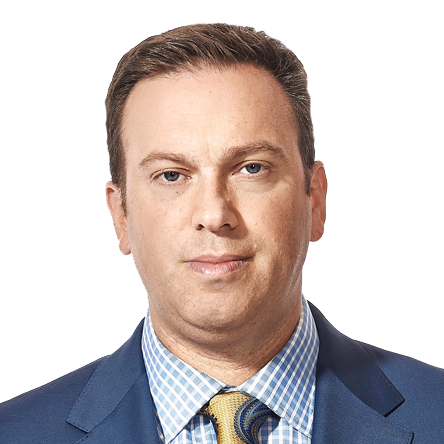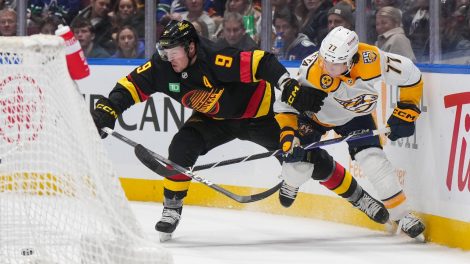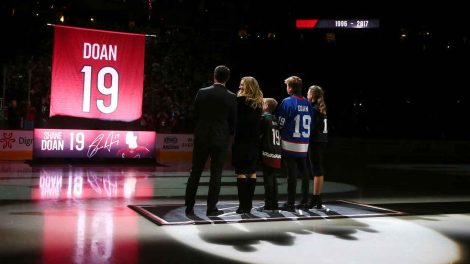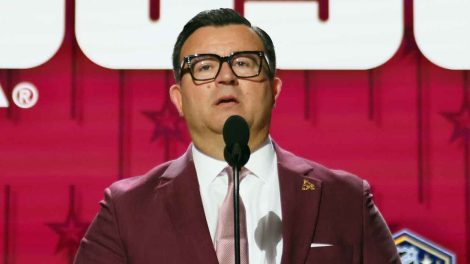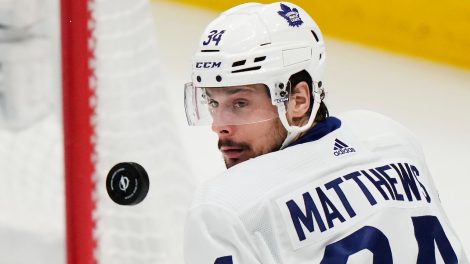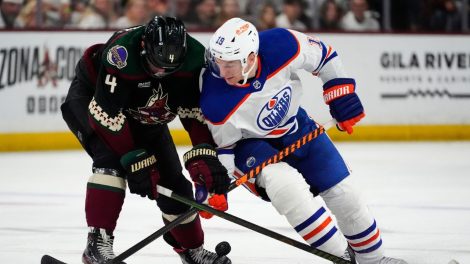There’s a book I’m meandering through titled Negotiating So Everyone Wins.
Near the end is a page describing nine basic considerations for closing. No. 7? “Emphasize the gains on both sides — drawbacks need to be left behind now.”
Here’s what I’ve learned over the years about negotiations:
Both sides happy? Good deal for everyone.
Both sides mostly happy, but wishing they’d gotten a bit more? Still a good deal for everyone, because both won and both lost.
One side happy, one side not so much? Hope you’ve got a good divorce lawyer.
Both sides unhappy? Welcome to the 2016 U.S. election.
Everyone did what they needed to do Tuesday morning in Winnipeg.
“I’ve committed to sign here,” Jacob Trouba told reporters. “When I signed that piece of paper everything changed in my mind.”
“I know there aren’t any hard feelings,” added captain Blake Wheeler. “You guys are making this too big of a deal. When it comes to players, we all support each other when it comes to business side of things.”
“He’s a Winnipeg Jet. I’m looking forward to him playing. I’m not looking to trade him,” GM Kevin Cheveldayoff said on Hockey Central at Noon. “There’s been no promises…We’re looking forward to Jacob playing for us.”
It’s a bit like a duck, though. Calm above the water, paddling like crazy underneath.
There’s no doubt neither Trouba nor the Jets wanted the last six months to unfold as they did. In the short term, this is a win for the team. It held strong and didn’t make a panic trade. The message is sent: “We will not capitulate.”
Trouba is back. And he can make a difference.
Winnipeg’s chief worry is Trouba’s mindset. He wanted to go and didn’t.
The good news is this doesn’t have the nastiness of Kyle Turris/Coyotes in 2011. Five years ago, there was some pretty obvious dislike between player and team.
There were Trouba jerseys worn by fans at the Heritage Classic in Winnipeg a few weeks ago. Cheveldayoff and agent Kurt Overhardt haven’t gone there. I’m sure they’re not always thrilled with each other, but they’ve been respectful.
His two-year, $6 million contract doesn’t hurt his trade value. No one who wants to acquire Trouba will be afraid of that dollar amount.
But I don’t see the Jets suddenly saying, “You know what, now that he’s signed, we’re lowering our demands for what we want in return.”
I’d be surprised if the organization’s attitude changes at all.
But at some point, Trouba’s going to end up on his weak side — the trigger point of all this. No matter how he feels, Trouba must realize one very important thing: his play will determine his future.
The Jets have to be disappointed neither Connor Hellebuyck nor Michael Hutchinson is grabbing a chokehold on the crease, but that’s a good-looking team with a ton of young talent.
It’s in Trouba’s own best interest to show up with a positive attitude and play great. A rising tide floats all boats. Winning makes everyone happy.
Trouba’s gains? Two of them. First and foremost, players want to play. Even if he wanted to be elsewhere, it’s better than sitting in your jammies all winter.
Second, the CBA gives teams their most leverage right at the end of a player’s entry-level contract. Then, things shift.
Winnipeg wanted a six-year deal, likely in the neighbourhood of $30-$33M. He left money on the table, but there’s a method to the madness. If Trouba plays to his capability, he’ll make it up and then some. And, by taking a shorter-term deal, he forces the issue in two summers if he still wants to. With arbitration rights at that time and unrestricted free agency looming, Trouba will have more control.
He just has to follow Bill Belichick’s advice: “Do your job…well.”
Trouba does that, and everyone wins — including the Jets.
30 THOUGHTS
1. How close did the Jets ever come to trading him? Tough to pinpoint exactly, but it doesn’t sound like anything ever really got tight. What it really came down to, I think, is teams who didn’t have what Winnipeg wanted searched around for three-way options. But whatever they tried couldn’t reach Cheveldayoff’s very high bar. When he says his desire was to keep Trouba, well, his actions back that.
2. There was a hilarious rumour going around that the Jets offered tickets to Trouba for last Friday’s game in Detroit and he joked about going in disguise. Alas, I’m told it’s not true. I think he was concerned about being a distraction, especially since the Jets were playing back-to-back.
3. It never ends for NHL GMs. Trouba is signed, sealed and delivered, but Cheveldayoff moves on to Alexander Burmistrov. Sounds like everyone recognizes it is time for a change of scenery.
4. The tight cap isn’t just making trades tough. Some teams have been surprised at who’s cleared waivers. But, as one GM added, “Maybe I shouldn’t be. No one’s got any room.”
5. Last week, while in Montreal, Canucks goalie Ryan Miller talked at length about family and his NHL career. After the conversation, some of the reporters wondered if he was considering retirement after this season, as his contract is up.
Answer: “No, I’m not thinking that way. I appreciate (hockey) and would love to play as long as I can,” he said last Friday. Miller and wife Noureen DeWulf have a son, Bodhi, who was born in March 2015.
“I have a better understanding of what European guys go through,” he says. “We have two careers in our household and are farther away from our families. Everyone is a little bit spread out and I want my wife to have a fulfilling and successful career of her own. It doesn’t last forever but this is not the swan song.”
Miller said he enjoyed the training he went through during the summer and likes the challenge of “adapting to more lateral plays (so far this season). We’re seeing lots of plays that wouldn’t have happened in the past.”
On the Canucks’ start: “People who know hockey and watch games know we don’t deserve the way this has gone. We’ve generated enough chances. Good teams go through similar stretches.”
6. Miller had a good theory on increased scoring and skill level of the young players: “They’ve figured out how to handle the composite sticks…know the kick points, how to catch a pass and handle the puck a little better.” You’ll remember when they first came out, controlling the puck (or passes) was a problem.
7. When you are going badly, other GMs don’t throw you a lifeline. They throw you an anvil. Teams are hoping a desperate Vancouver is willing to part with 2015 first-rounder Brock Boeser and 2016 version Olli Juolevi.
I can’t see it happening unless the haul is incredible. The Canucks are very excited about those two players. One thing to note about Vancouver: they only have 45 contracts (of a maximum 50). There’s some flexibility.
8. As Vancouver went through eastern Canada en route to New York State, it became clear that hockey operations does not wish to scapegoat Willie Desjardins for what’s happening. Heading into Saturday’s game in Toronto, the Canucks had dressed 24 skaters so far this season. Sixteen of them had a shooting percentage of 0.0.
Eleven games in? That’s unheard of. Included are Loui Eriksson (career percentage of 13.7, 13th among active players), Alexandre Burrows (12.2, 45th) and Sven Baertschi (12, just outside top 50). I’ve asked GMs before about firing coaches, and they always say some version of, “Does the team still play for the coach? Does your team push back during games?” You cannot fault the players’ effort. They are competing. All eyes are on ownership.
9. One of the reasons the Canucks haven’t used Eriksson with the Sedins too often? With Daniel and Henrik down low, you’re playing with fire by having a third forward in that area, since the responsibility is to stay higher and protect against odd-man rushes. But Eriksson likes to play in front of the net, so he’s not able to go where he’s comfortable. At some point, Vancouver is going to have to commit to a long run of trying to make it work, but it’s hard to do that when you need wins.
10. GM meetings are coming up and the Nazem Kadri/Daniel Sedin hit is going to be an added topic of conversation. I didn’t like it at all, as I’m not sure what Sedin is supposed to do there. He’s not admiring a pass, he’s in the act of scoring a goal.
The rule was re-written in 2012 to eliminate the term “blind side,” so since Kadri’s initial contact was with the body, the Department of Player Safety was limited in what it could do. But there are some GMs (including Jim Rutherford and Ray Shero) who believe the NHL should always be trying to protect the head.
The question always is, though, can they come up with language that enough of them agree on? Hope so. No one needs to see that play out again.
11. One thing to watch as the Canucks pursue free agents? The 15 per cent tax levied on foreign buyers in the white hot Metro Vancouver housing market. I’m not sure if this is going to become an issue, but a couple of agents said they had some sticker shock when they ran some numbers.
12. One final note on Vancouver: had a chance to chat Saturday morning with Troy Stecher. I asked him about his strong positional play and ability to take the right angles — especially important for someone who isn’t a physical monster.
He credited his old skills coach, Yogi Svejkovsky, for implementing a lot of that. Svejkovsky, who played 113 NHL games, worked with Stecher for two years at Vancouver Hockey School when the current Canuck was a 14 and 15.
Svejkovsky refused to take all the credit.
“(Stecher) had good coaches along the way. Whoever was developing him was already teaching that side of the game. You don’t know what size a player is going to be, so I treat every single player as a small player…how to be evasive. In small areas during a two-on-one drill, how do I push my hands to one spot, slide my hands to another spot? How do you stop offensive players?”
Svejkovsky compared Stecher to Brendan Gallagher, in a way.
“What I enjoyed about Troy is that he was really observant. Good players — and Brendan Gallagher is the same — they separate themselves in two ways: they love the game and they observe.”
13. At that age, Svejkovsky said Stecher was missing power. His shot, for example, had good technique, but not enough oomph behind it. What he did have was anticipation and an understanding of what you can allow defensively. Svejkovsky’s father was a goalie.
“He gave me an awareness to always know where is the middle the ice, so you are hardly out of position. Where is the middle? What can I give up? If your feet are facing the wrong way, or you are pivoting the wrong way, a good player will make a play.” Stecher comprehends all that.
14. A bit of a buzz on the weekend when three Anaheim staffers (director of player personnel Rick Paterson, special assignment scout Dave Nonis and scout Mike Stapleton) were listed at back-to-back AHL Grand Rapids games. Nonis ended up going elsewhere, but considering Anaheim’s reported interest in Anthony Mantha, it raised eyebrows.
15. As Sidney Crosby and Connor McDavid prepare for their first meeting, you’re hearing more and more opinions indicating McDavid is closing the gap on being the best player in the NHL, with some saying he’s there already. One coach gave a reason why I still think Crosby is number one, although I agree McDavid’s rise towards that position is coming faster than expected. The coach says Crosby is “playing incredible” and “demands a compete level from those playing around him.”
I don’t spend as much time around the Penguins as other reporters do, but I’ve always sensed his moods and feelings have an enormous effect on the team. When he’s going like this, he pulls them higher. I don’t think McDavid has that — yet. (And the key word is “yet.”) But he will get there and then the battle for number one will truly be on.
16. Very early in my career, I covered a Toronto Blue Jays game where Cito Gaston left a pitcher in the game who was just getting clobbered. (Think it was David Wells, but not certain.) Gaston went to the mound, said his bullpen was exhausted and he needed Wells to eat it. Told the situation, Wells did as was requested.
Was reminded of that watching Al Montoya get tuned by Columbus on Friday night. If it was any goalie other than Carey Price, I have no doubt Montoya gets removed. One thing I wondered: would the Canadiens ever consider dressing a third goalie and giving Price a night off to prevent that from happening again?
17. One coach thought he’d consider that, because of the way the Canadiens reacted. Seeing that Price wasn’t entering, they packed it in and Columbus took advantage. If Montoya gets a mercy pull, do the Canadiens respond better?
Also: “Michel Therrien never imagines Columbus is going to score 10. Even when it’s 3-0 in the first, he doesn’t think it will be that bad. No one ever thinks someone is scoring 10 goals on you.”
18. Toronto is the fourth team in the last 25 years to have seven rookies play in a game after Nov. 1. The first two, the 1991-92 San Jose Sharks and 2003-04 Chicago Blackhawks, missed the playoffs. The 2013-14 Tampa Bay Lightning made it, although an injury to Ben Bishop ended their chances against Montreal in the first round.
The difference between those Lightning and these Maple Leafs? Tampa’s rookies were older. They had eight play at least 43 games that season, and only one (Nikita Kucherov) was younger than 23. He was 20. By comparison, Toronto’s three best rookies so far — Mitch Marner, Auston Matthews and William Nylander — are 19, 19 and 20.
19. Ron MacLean had a good theory as to why Tampa may have succeeded when others failed: The Sharks and Blackhawks tried in an era where the league trended towards older players and more obstruction. It’s different now. Still don’t think Toronto is a playoff team, but we’ll see how much better they fare than the Blackhawks, who finished last in the West and missed the playoffs by 32 points. San Jose was an expansion team, which really isn’t a fair comparison.
20. Last week was the Karjala Cup, a pro tournament scouted by NHL teams that is hosted by Finland. The Czech Republic, Russia and Sweden also compete. Usually there’s a diamond in the rough or two, but scouts were down on what they saw this year. (Or, they’re just hiding what they liked.)
One player I did get a thumbs up on: Russia’s Nikita Gusev, who had four points in three games as his country went undefeated. Gusev, taken 202nd in the 2012 draft by Tampa Bay, will be 25 in July. I came across some interviews where he’s said he’d like to come over sometime, as Kucherov is one of his close friends. But no idea if he actually will.
21. Some interesting family connections at the Under-17s last week in Sault Ste Marie. On the Czech team was Zack Malik, who was actually born in Raleigh, NC. He’s retired NHLer Marek Malik’s son.
Listed at 6-foot-2 and 160 pounds, he’s got plenty of room to fill out. He isn’t as well known as some of the other family connections (we’ll get to those in a minute), but I think teams are going to watch him more closely from now on. Did he go between his legs on a breakaway, like his father famously did? “No,” one scout said with a laugh.
22. Nolan Foote, whose father Adam won a Stanley Cup in 2001 and a gold medal in 2002, further established himself. Also getting positive reviews were Benoit-Olivier Groulx, son of Benoit, who coached Canada to gold at the 2015 World Juniors, and Russia’s Andrei Svechnikov. His brother, Evgeny, was taken 19th overall by Detroit in the 2015 draft. The younger brother does not lack for talent.
23. Frederik Andersen is settling down, winning three straight heading into Tuesday’s game against Los Angeles. The second of those victories, last Thursday against Buffalo, was straight out of the 1980s. You don’t see the wild, diving saves he was making that night anymore.
His father, Ernst, a carpenter, is also the goalie coach for the Danish National Team. They text after Ernst watches Frederik’s games, but the son says the father doesn’t always like to confuse the issue by offering advice. He was laughing at some of Frederik’s saves that night, though. Best advice Ernst gave Frederik: “Force the shooter to make his move first.”
24. Karri Ramo showing up at Maple Leafs practice sure seems like a warning for Jhonas Enroth.
25. Sounds like there are some Ontario Hockey League teams willing to acquire Lawson Crouse from the Kingston Frontenacs, but they have to make sure Arizona sends him back first.
26. Ottawa Mayor Jim Watson wants to meet with the Senators about a possible outdoor game elsewhere in the city, but the team and NHL were really hoping for Parliament Hill. “Go big or go home” was the motto. The league was looking at a 25,000-30,000 seat “pop-up” stadium next December, but logistics were as big an issue as dollars. It would have taken months to build the facility and the Canadian government didn’t want that disruption while Parliament was in session. I’m told it’s already hard enough to find parking around all the downtown Ottawa construction. Very disappointing. Would have been spectacular.
27. The NHL and NHLPA are in discussions about it, but the league’s proposal for All-Star balloting would disqualify any player not in the National Hockey League. How does the union feel? Tough to say at this point, but a couple of factors they may weigh will be: can the John Scott phenomenon work that well again? And if you want to promote your stars during this weekend, shouldn’t it be all about them?
28. I mentioned the GMs wanting to discuss the Kadri/Sedin hit at their meetings. Don’t forget Vincent Trocheck’s shootout goal from Oct. 18 versus Tampa will be on the agenda as well. Do they feel that one should have counted?
29. As readers of this blog know, I keep a Nov. 1 stat. Teams who are four points out of the playoffs on that date historically don’t make it to the post-season. Since 2005-06, only six of 48 teams have overcome that deficit, with Anaheim accomplishing it last season.
This year, no one was four points out on that date. We did have a later start due to the World Cup, so I’m asking a math whiz if it’s fair to move the test date one week. Will get back to you on that.
30. Kevin Cheveldayoff and Kurt Overhardt met face-to-face on Friday in the stairwell at Joe Louis Arena. Not sure how many people recognized the significance of the conversation, but it brought back one great memory:
At the 1998 Stanley Cup Final, I was charging down the stairs for the end-of-game media availabilities and ran right into Anna Kournikova. I did an embarrassing triple-take, and she looked at me like, “Why don’t you take a picture? It will last longer.”
Ah, good times.

